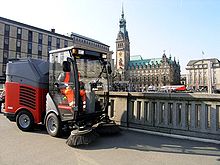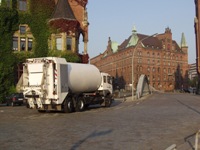City cleaning Hamburg
| City cleaning Hamburg
|
|
|---|---|
| legal form | Institute of public right |
| founding | 1994 |
| Seat | Hamburg , Germany |
| management | Management: Rüdiger Siechau Holger Lange Chairman of the supervisory board: |
| Number of employees | 3,259 (2018) |
| sales | 394 million euros (2018) |
| Branch | Waste management |
| Website | http://www.stadtreinigung.hamburg |
The City of Hamburg (SRH) is Hamburg's largest service provider in the field of waste management . With around 3,000 employees, it operates as a full-service provider in the public, commercial and private sector and is responsible for the collection of residual , organic and household waste in around 900,000 households . The SRH has been an institution under public law (AöR) since 1994 .
History of city cleaning in Hamburg
Beginnings
The plague epidemic of 1507 also affected Hamburg. It caused many cities to reorganize their city cleaning. The first cleanliness ordinance of 1560 in Hamburg stipulated that busy streets and marketplaces had to be cleaned four times a year at public expense. 37 years later there was another plague epidemic in Hamburg, whereupon convicts had to bring the rubbish out of the city in carts. In 1611 the City Council of Hamburg set up the "Gassendeputation". She should take care of the paving and keeping the streets in Hamburg clean. In 1623 "dirt guides" were employed to keep the streets and houses clean. These were under the supervision of captains of the vigilante group. Regular street cleaning was first introduced in Hamburg in 1710. Cleaning and removal operations were outsourced to tenants.
In 1886 the city cleaning, which had been privately run until then, was put under state management, more precisely to the " building deputation ". The tasks included street cleaning and the collection of household waste. For this purpose, the city was divided into twelve zones, each of which must be kept clean by a responsible supervisor. Most of the work was done at night and the majority of the employees were former sergeants or sergeants. The only things that remained in private hands were the horses for the water carts and sweepers.
After the cholera epidemic of 1892 , the Hamburg building deputation decided to build a waste incinerator based on the English model. In 1894, the trial operation of the waste incineration plant on Bullerdeich began. Operations started four years later.
In 1910 the waste incineration plant on Alten Teichweg was put into operation and shortly afterwards, in 1913 , the MVA Ruhrstraße went into operation in Altona , Prussia . The facility on Bullerdeich was shut down in 1924 and replaced by the waste incineration plant in Borsigstrasse. Constantly growing amounts of dangerous chemicals in household waste and in production waste made a disposal option with special incineration and flue gas cleaning techniques necessary, which is why the hazardous waste incineration plant in Borsigstrasse was put into operation in 1972. The current waste incineration plant on Schnackenburgallee was put into operation in 1973. It was supplemented in 1997 with a block-type thermal power station.
City cleaning office
The Stadtreinigung Hamburg (AöR) today has historically developed from the city cleaning office of the building authority . The city cleaning office existed until 1988.
Hamburg City Cleaning Office
On the basis of an audit report by the Court of Auditors of the Free and Hanseatic City of Hamburg from 1984, the results of an official steering group and the results of an investigation committee set up by the Hamburg citizenship in 1985 to review the "tasks, scope, legality, planning, profitability, fee structure and information behavior of city cleaning" took place in 1988 the conversion of the office for city cleaning into the state office of Hamburg city cleaning (LB-HSR).
City cleaning Hamburg AöR
1994 LB HSR and the city cleanings were districts Bergedorf and Harburg built the City of Hamburg as a legal entity under public law (ipc).
City cleaning Hamburg (today)
Stadtreinigung Hamburg AöR (SRH) has two organs, the management and the supervisory board. The managing directors are Professor Dr. Rüdiger Siechau and Holger Lange. Michael Pollmann, the State Councilor for the Environment and Energy, chairs the Supervisory Board.
SRH also has other subsidiaries and holdings. So the SRH is under the umbrella SRH Verwaltungsgesellschaft mbH (SRHV) z. B. 100% stake in MVB Müllverwertung Borsigstraße GmbH (MVB).
Activities and offers of the Hamburg city cleaning service
Lectures and guided tours
Lectures and demonstrations are held at the recycling yards or in the former Stellinger Moor waste incineration plant . Upon request, the customer advisors can also come to kindergartens and schools and give short lectures on recycling and waste management. The two-megawatt system right next to the Stellinger Moor MVA generates around 330 cubic meters of biogas per hour, which is converted into electricity and district heating in the connected combined heat and power unit (CHP) .
Bützberg composting plant
The biogas and composting plant Bützberg in Tangstedt , built in 1995, processes up to 30,000 tons of biogenic waste annually . Since December 1, 2012, up to 600 cubic meters of biogas have been produced every hour in the connected dry fermentation plant . The system has been operated by the Hamburg city cleaning agency since January 1st, 2009.
The Bützberg composting plant has a 22 meter wide and 125 meter long composting hall. In 21 fermenters is biogas obtained. To clean the biogas, a processing system is connected to the dry fermentation system , which feeds the biogas in natural gas quality into the gas supply network.
Among other things, biogenic waste from more than 100,000 Hamburg biotons is used for recycling . The delivered organic waste is freed from foreign matter with a sieve system. Then a screw mill crushes the waste to a size of eight centimeters. The shredded waste is filled into the fermenter, where biogas is extracted from the waste for three weeks in the absence of air. After this process, the digestate is used in the composting plant. The composting process takes place in ten well-ventilated rotting fields in the rotting hall. With the help of the Wendelin , a machine with a three-meter high paddle wheel, the rents are shifted twice a week. The finished compost is certified by a RAL seal of approval and is sold loose or in sacks, for example at the Hamburg city cleaning service's recycling yards.
Web links
- City cleaning Hamburg
- BioWerk Hamburg
- Law establishing the Hamburg City Cleaning Agency (Stadtreinigungsgesetz - SRG)
- Stadtreinigung Hamburg - key figures - in figures. Retrieved April 27, 2019 .
Individual evidence
- ↑ Imprint with management board and supervisory board details , accessed on November 26, 2016
- ↑ Stadtreinigung Hamburg - key figures - in figures. Retrieved April 26, 2020 .
- ↑ DATES AND FACTS 2016 - 2018. Accessed April 26, 2020 .
- ↑ Law on the establishment of the Hamburg city cleaning facility (Stadtreinigungsgesetz - SRG). (PDF) Landesrecht online, March 9, 1994, accessed on April 26, 2020 .
- ^ Ernst Christian Schütt: Die Chronik Hamburgs , Chronik Verlag, Dortmund 1991, p. 299
- ↑ Drs. 14/4192. (PDF) Citizenship of the Free and Hanseatic City of Hamburg, May 25, 1993, accessed on April 26, 2020 .
- ↑ Drs. 11/2888 Report of the Court of Auditors (distributed only to the members of the citizenship). (PDF) Citizenship of the Free and Hanseatic City of Hamburg, August 30, 1984, accessed on April 25, 2020 .
- ↑ Drs. 11/6666 (final report). (PDF) Citizenship of the Free and Hanseatic City of Hamburg, August 30, 1984, accessed on April 25, 2020 .
- ↑ Drs. 13/1135. (PDF) Citizenship of the Free and Hanseatic City of Hamburg, February 6, 1988, accessed on April 26, 2020 .
- ↑ Drs. 14/4192 (draft of the Senate for a law on city cleaning Hamburg). (PDF) Citizenship of the Free and Hanseatic City of Hamburg, May 25, 1993, accessed on April 26, 2020 .
- ↑ Imprint. City cleaning Hamburg, accessed on April 26, 2020 .
- ↑ Organization chart. City cleaning Hamburg, accessed on April 26, 2020 .
- ^ SRH shareholding structure. City cleaning Hamburg, accessed on April 26, 2020 .
- ↑ Brochure from the Hamburg city cleaning service about the Bützberg biogas and composting plant
- ↑ Information from the Hamburg city cleaning service about the composting plant
- ↑ Brochure from the Hamburg city cleaning service about the Bützberg biogas and composting plant
- ↑ Information from the Hamburg city cleaning service about the composting plant
- ↑ Information from the Hamburg city cleaning service about the composting plant
- ↑ Stadtreinigung Hamburg buys Kompostwerk Bützberg ( memento of the original from January 14, 2015 in the Internet Archive ) Info: The archive link was inserted automatically and not yet checked. Please check the original and archive link according to the instructions and then remove this notice. , Message on www.recyclingmagazin.de January 14, 2009



